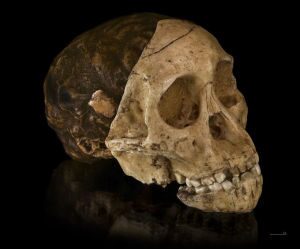
There may be a fly in the ointment for some evolutionists when it comes to early brain adaptations in human evolutionary theory.
It revolves around a recent study of the endocast (internal cast of the space occupied by the brain in the skull) of the famous 3 million-year-old ‘Taung Child’ fossil discovered in South Africa in 1924. This find was advanced by Wits University Professor Raymond Dart in 1925 as evidence of an early hominin or “ape-man” species (Australopithecus africanus), a forerunner in human evolutionary beginnings. Among other things, it has been cited as having “historical and scientific importance in the fossil record as the first and best example of early hominin brain evolution”.* The theory is that it exhibits key cranial adaptations in its morphology that suggest, like modern human infants and toddlers, that certain features of the infant cranium provided the flexibility for continued growth and development in the prefrontal region of the brain, the region responsible for complex cognitive behavior, personality expression, decision making, and moderating social behavior, during infancy. In short, the Taung Child may have exhibited the first signs of ‘becoming human’ in terms of the human brain.
But not so fast, say a team of scientists……….
To test the ancientness of this evolutionary adaptation, Dr Kristian J. Carlson, Senior Researcher from the Evolutionary Studies Institute at the University of the Witwatersrand, Professor Ralph L. Holloway from Columbia University and Douglas C. Broadfield from Florida Atlantic University, performed an in silico dissection of the Taung fossil using high-resolution computed tomography at the Wits University Microfocus X-ray Computed Tomography (CT) facility. It was the first such examination ever conducted on the Taung Child fossil specimen.
“A recent study has described the roughly 3 million-year-old fossil, thought to have belonged to a 3 to 4-year-old, as having a persistent metopic suture and open anterior fontanelle, two features that facilitate post-natal brain growth in human infants when their disappearance is delayed,” said Carlson, referring to a study published in 2012 in the Proceedings of the National Academy of Sciences by Dean Falk of Florida State University and colleagues.
The CT scans conducted by Carlson and his colleagues, however, showed otherwise. Citing deficiencies in how the Taung fossil material has been recently assessed as presented in the 2012 study report, the researchers suggest physical evidence does not incontrovertibly link features of the Taung skull, or its endocast, to early prefrontal lobe expansion.
_______________________________
The Taung Child fossil at the Evolutionary Studies Institute at Wits University. Credit: WITS UNIVERSITY
______________________________
“In sum, we believe the claim of high frequencies of metopic sutures in early hominins is premature, and thus the proposition that delayed metopic suture closure may have conferred a selective advantage in early hominin evolution is equally premature,” write the researchers in their report.*
Thus, results of the new study show that there is still no evidence for this kind of skull adaptation that evolved before Homo (the genus that includes modern humans and species closely related to them), nor is there evidence for a link between such skull characteristics and the proposed accompanying early prefrontal lobe expansion, Carlson said.
The study is published online in the journal Proceedings of the National Academy of Sciences (PNAS), in an article titled: New high resolution CT data of the Taung partial cranium and endocast and their bearing on metopism and hominin brain evolution.
_________________________________________
*Holloway, R.L., Broadfield, D.C., Carlson, K.J., New high resolution CT data of the Taung partial cranium and endocast and their bearing on metopism and hominin brain evolution; Proceedings of the National Academy of Sciences, 25 August 2014.
Article written with adaptations and edits from a University of Witwatersrand press release.
Cover Photo, Top Left: Endocranium, face and mandible of the Taung Child (Australopithecu africanus). Didier Descouens, Wikimedia Commons
_________________________________________________
Travel and learn with Far Horizons.
Read about the most fascinating discoveries with a premium subscription to Popular Archaeology Magazine. Find out what Popular Archaeology Magazine is all about. AND MORE:
On the go? Get the smartphone version of Popular Archaeology as an app or as an ebook.
Popular Archaeology’s annual Discovery Edition eBook is a selection of the best stories published in Popular Archaeology Magazine in past issues, with an emphasis on some of the most significant, groundbreaking, or fascinating discoveries in the fields of archaeology and paleoanthropology and related fields. At least some of the articles have been updated or revised specifically for the Discovery edition. We can confidently say that there is no other single issue of an archaeology-related magazine, paper print or online, that contains as much major feature article content as this one. The latest issue, volume 2, has just been released. Go to the Discovery edition page for more information.







